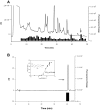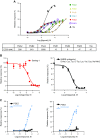Receptor-specific crosstalk between prostanoid E receptor 3 and bombesin receptor subtype 3
- PMID: 29401613
- PMCID: PMC5956246
- DOI: 10.1096/fj.201700337RR
Receptor-specific crosstalk between prostanoid E receptor 3 and bombesin receptor subtype 3
Abstract
Bombesin receptor subtype 3 (BRS-3) is a GPCR that is expressed in the CNS, peripheral tissues, and tumors. Our understanding of BRS-3's role in physiology and pathophysiology is limited because its natural ligand is unknown. In an attempt to identify this ligand, we screened toad skin ( Bufo bufo gargarizans Cantor) extracts and identified prostaglandins as putative ligands. In BRS-3-transfected human embryonic kidney (HEK) cells, we found that prostaglandins, with prostaglandin E2 (PGE2) being the most potent, fulfill the pharmacologic criteria of affinity, selectivity, and specificity to be considered as agonists to the BRS-3 receptor. However, PGE2 is unable to activate BRS-3 in different cellular environments. We speculated that EP receptors might be the cause of this cellular selectivity, and we found that EP3 is the receptor primarily responsible for the differential PGE2 effect. Consequently, we reconstituted the HEK environment in Chinese hamster ovary (CHO) cells and found that BRS-3 and EP3 interact to potentiate PGE2 signaling. This potentiating effect is receptor specific, and it occurs only when BRS-3 is paired to EP3. Our study represents an example of functional crosstalk between two distantly related GPCRs and may be of clinical importance for BRS-3-targeted therapies.-Zhang, Y., Liu, Y., Wu, L., Fan, C., Wang, Z., Zhang, X., Alachkar, A., Liang, X., Civelli, O. Receptor-specific crosstalk between prostanoid E receptor 3 and bombesin receptor subtype 3.
Keywords: BRS-3 receptor; EP3 receptor; PGE2; toad skin.
Conflict of interest statement
This work was supported by U.S. National Institutes of Health (NIH) National Institute on Drug Abuse Grant DA024746, and the Eric L. and Lila D. Nelson Chair in Neuropharmacology (to O.C.). This work was also supported by the National Natural Science Foundation of China Key Program 21135005 (to X.L.), and Grant 81402806 (to Y.Z.). The authors declare no conflicts of interest.
Figures





Similar articles
-
Prostaglandin E2-prostanoid EP3 signal induces vascular contraction via nPKC and ROCK activation in rat mesenteric artery.Eur J Pharmacol. 2011 Jun 25;660(2-3):375-80. doi: 10.1016/j.ejphar.2011.03.032. Epub 2011 Apr 2. Eur J Pharmacol. 2011. PMID: 21463619
-
Possible involvement of brain prostaglandin E2 and prostanoid EP3 receptors in prostaglandin E2 glycerol ester-induced activation of central sympathetic outflow in the rat.Neuropharmacology. 2014 Jul;82:19-27. doi: 10.1016/j.neuropharm.2014.03.005. Epub 2014 Mar 19. Neuropharmacology. 2014. PMID: 24657150
-
The key residue within the second extracellular loop of human EP3 involved in selectively turning down PGE2- and retaining PGE1-mediated signaling in live cells.Arch Biochem Biophys. 2017 Feb 15;616:20-29. doi: 10.1016/j.abb.2016.12.001. Epub 2017 Jan 5. Arch Biochem Biophys. 2017. PMID: 28065721
-
The receptor EP3 to PGE2: A rational target to prevent atherothrombosis without inducing bleeding.Prostaglandins Other Lipid Mediat. 2015 Sep;121(Pt A):4-16. doi: 10.1016/j.prostaglandins.2015.10.001. Epub 2015 Oct 14. Prostaglandins Other Lipid Mediat. 2015. PMID: 26463849 Review.
-
Prostaglandin E2-induced inflammation: Relevance of prostaglandin E receptors.Biochim Biophys Acta. 2015 Apr;1851(4):414-21. doi: 10.1016/j.bbalip.2014.07.008. Epub 2014 Jul 17. Biochim Biophys Acta. 2015. PMID: 25038274 Review.
Cited by
-
BRS3 in both MC4R- and SIM1-expressing neurons regulates energy homeostasis in mice.Mol Metab. 2020 Jun;36:100969. doi: 10.1016/j.molmet.2020.02.012. Epub 2020 Feb 29. Mol Metab. 2020. PMID: 32229422 Free PMC article.
-
NPY/NPF-Related Neuropeptide FLP-34 Signals from Serotonergic Neurons to Modulate Aversive Olfactory Learning in Caenorhabditis elegans.J Neurosci. 2020 Jul 29;40(31):6018-6034. doi: 10.1523/JNEUROSCI.2674-19.2020. Epub 2020 Jun 23. J Neurosci. 2020. PMID: 32576621 Free PMC article.
-
Brs3 neurons in the mouse dorsomedial hypothalamus regulate body temperature, energy expenditure, and heart rate, but not food intake.Nat Neurosci. 2018 Nov;21(11):1530-1540. doi: 10.1038/s41593-018-0249-3. Epub 2018 Oct 22. Nat Neurosci. 2018. PMID: 30349101 Free PMC article.
References
-
- Fathi Z., Corjay M. H., Shapira H., Wada E., Benya R., Jensen R., Viallet J., Sausville E. A., Battey J. F. (1993) BRS-3: a novel bombesin receptor subtype selectively expressed in testis and lung carcinoma cells. J. Biol. Chem. 268, 5979–5984 - PubMed
-
- Jensen R. T., Battey J. F., Spindel E. R., Benya R. V. (2008) International Union of Pharmacology. LXVIII. Mammalian bombesin receptors: nomenclature, distribution, pharmacology, signaling, and functions in normal and disease states. Pharmacol. Rev. 60, 1–42 10.1124/pr.107.07108 - DOI - PMC - PubMed
Publication types
MeSH terms
Substances
Grants and funding
LinkOut - more resources
Full Text Sources
Other Literature Sources
Molecular Biology Databases
Miscellaneous

